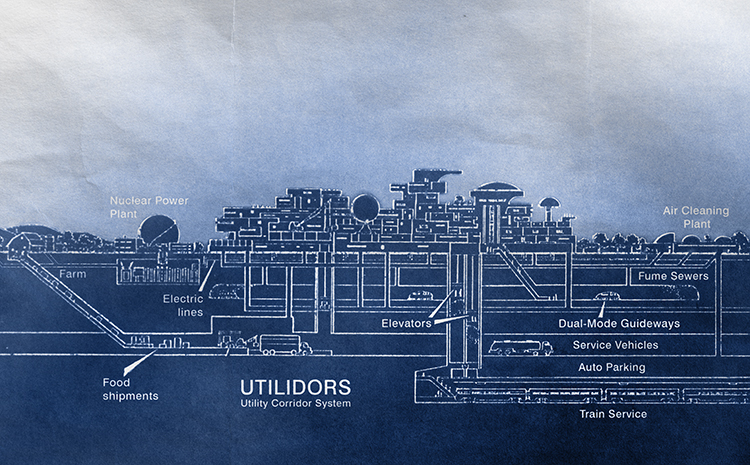Oct. 17, 2017 Ι CityLab
To forestall the continuing growth of cities as “cancerous organisms,” the Minnesota Experimental City (MXC) was conceived in the mid-1960s by epochal technologist Athelstan Spilhaus. A modular settlement of 250,000 people or more, the city was to be powered by clean energy and run on public transit. Experimental City would be a tabula rasa—a place to begin anew, free from the constraints and compromises of past cities, located in the remote marshlands of northern Minnesota.
Spilhaus could be gruff, but maintained a patrician air, expressed in his decades-running “Our New Age” comic strip, which confidently proclaimed science fiction to be science fact just around the corner. To advance the cause, he gathered around him a progressive cadre of experts including Buckminster Fuller and civil rights pioneer Whitney Young. The world they outlined was startlingly prescient.
Spilhaus was far ahead of the day’s consensus on climate change and the necessity of minimizing waste. (One newspaper headline: “’Recycling’ to be key to experimental city.”) The MXC predicted the rise of personal computers, video conferencing, and a proto-Internet that would allow networked remote shopping and banking. They envisioned how this technology would allow people to work from home, and extrapolated the subsequent effects on transit networks and urban development.
A “dual-mode” transit network addressed the first-mile, last-mile problem with individual vehicles that can be driven independently, but then hook into a series of cars running on a track as they near the city center. No traditional internal combustion engines would be allowed. Spilhaus envisioned an almost organic process of assembly and disassembly, in which modular components of buildings would be digested into the city sub-structure and used again. His experimental city was always a work in progress, constantly making and unmaking itself to perform better.
Animated by both conservationism and NIMBY populism, the people of Swatara wanted no part in the MXC experiment, even though it sought to solve many of their ostensible concerns about dysfunctional urbanism. They marched more than 150 miles from their town to the state capital in St. Paul in a Minnesota January as protest. The MXC lost state support in 1973, effectively killing the project.
At the same time, there was an equally compelling conflict between the two approaches to environmentalism. Spilhaus very much believed in solving things with grand gestures and [that] it was solvable with technology. The history of environmentalism was rooted in a much more hands-off approach. Human hands corrupt nature.
Was it a canny political step for Spilhaus to refuse to explain how the MXC would look, so he wouldn’t be tied to a specific vision that might become unpopular? Or was it a blunder not to delineate a common vision early on so that everyone could unite around it?
When you listen to recordings of the workshops and the steering committee meetings, it comes up over and over again: the idea of a mile-wide dome as something that is not only utilitarian, but something that acts as a giant symbol for the city. A concrete image was needed, and they did locate that in the dome.
They ran these workshops at the University of Minnesota from 1967 to ’68 on all manner of topics, technological as well as social. Some of these workshops were about education vis-à-vis the computer. That was viewed as something that would allow students to integrate into a school system through the computer, rather than their physical presence. In addition, [there was] the idea of the city as a kind of learning community, something that you could learn from—a kind of transparent city where students could be brought around and learn how cities actually function.
Why have urbanists and policy leaders lost their ability to dream big, like with the Experimental City? And what can the MXC teach us?
I don’t know if urbanism is distinct from society, and I think there has been a general suspicion of this kind of project. Even amongst those who wish we could dream big, it seems foolhardy. I don’t see it being politically viable. There was a moment, in that post-World-War-II era, where we really got behind those big projects. There was a peak in this kind of project in the 1960s that made it conceivable to propose. As to why we don’t have those anymore, I would just try to identify one [factor]: A cynicism or tamping down of optimism.
A caveat to that is that they tried it, and they weren’t able to influence the future so much. Maybe that idea was bankrupt from the beginning. You can’t plan for the future. Humans don’t have the technical capacity, or the deep-down emotional capacity, to be able to plan for 20 years off. I can see it both ways. That’s the thing that really drew me to the project. There was something about a city that was going to improve all the other cities that was a very beautiful and noble idea, but at the same time, those counter arguments against that mentality were equally compelling, and that clash was really interesting.
